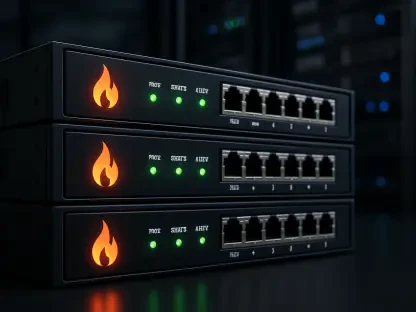Imagine a world where artificial intelligence drives every corner of technology, from personal assistants to complex business analytics, but the infrastructure to support this revolution is stretched to its breaking point. This is the reality facing tech giants today as the demand for AI computing power surges beyond the limits of traditional data centers. With a staggering $33 billion investment in neocloud providers—smaller, specialized firms offering AI-focused computing resources—a major tech player has taken a bold step to address this crisis. This roundup dives into diverse perspectives from industry leaders, analysts, and tech strategists to unpack the implications of such a massive commitment, exploring how it reshapes the AI landscape and what it means for the future of cloud computing.
Diving into the AI Capacity Crunch: Why This Investment Matters
The explosion of generative AI technologies has created an unprecedented need for computational resources, outpacing the capabilities of even the largest data center networks. Industry observers note that the energy-intensive nature of AI model training, coupled with the rapid adoption of AI tools by businesses and consumers, has left many companies scrambling for solutions. This investment of $33 billion in neocloud partnerships signals a pivotal shift, aiming to bridge the gap between soaring demand and limited supply.
Analysts highlight that neoclouds—nimble providers leasing specialized AI hardware—offer a faster path to scaling capacity compared to building new facilities from scratch. Some experts argue that this move is not just a temporary fix but a strategic pivot toward a more flexible infrastructure model. Others caution that reliance on external providers could pose risks, sparking a debate on whether speed should take precedence over control in such a competitive field.
A key point of discussion is the financial agility this approach provides. By classifying neocloud partnerships as operational expenses rather than capital investments, the company can optimize cash flow and adapt to market shifts more readily. Financial strategists emphasize that this tactic could set a precedent for how tech firms manage the high costs of AI innovation, though opinions differ on the long-term sustainability of such outsourcing.
Unpacking the Neocloud Strategy: Diverse Views on Industry Impact
Partnerships Fueling AI Growth: A Game-Changing Collaboration
The cornerstone of this $33 billion initiative lies in partnerships with neocloud providers, including a major deal valued at up to $19.4 billion for access to cutting-edge Nvidia chips. Tech industry watchers describe this as a brilliant move, enabling rapid access to hardware that is often in short supply. Many agree that collaborating with smaller, specialized firms allows for quicker deployment of AI capabilities than traditional infrastructure expansion.
However, not all perspectives are uniformly positive. Some analysts raise concerns about the potential vulnerabilities of entrusting critical AI workloads to external entities, pointing to risks like data security and service reliability. They argue that while the urgency to meet market demand is undeniable, the trade-off could expose strategic weaknesses if partnerships falter.
A balanced view emerges from operational experts who suggest that these collaborations are a necessary evolution in a fast-moving sector. They note that neocloud providers have often already secured power and hardware resources, reducing logistical hurdles. The consensus leans toward cautious optimism, with many seeing this as a temporary but vital solution to an immediate crisis.
Balancing Internal and External AI Demands: A Dual Approach
One intriguing aspect of this strategy is the redistribution of computing resources, with internal AI tasks offloaded to neoclouds to prioritize client-facing services. Technology consultants praise this dual focus, arguing that it maximizes the utility of existing data centers for high-demand offerings like developer tools and third-party AI integrations. This flexibility, they say, is crucial for maintaining a competitive edge.
On the flip side, infrastructure specialists warn that ceding control over core AI processes could complicate long-term planning. They stress that while freeing up internal servers for customer needs is practical, it risks creating dependency on external providers for foundational workloads. This tension between immediate gains and future stability remains a hot topic among industry voices.
A third perspective comes from business strategists who see this as a calculated risk worth taking. They point out that the ability to scale client services quickly aligns with investor expectations for returns on AI investments. The debate continues on whether this balance can be sustained without compromising the integrity of proprietary systems.
Neoclouds Redefining Cloud Computing: A New Frontier
The rise of neoclouds as a solution to AI capacity challenges has caught the attention of cloud computing experts, who view it as a transformative shift in industry dynamics. These smaller providers are seen as agile players capable of addressing niche demands, especially in regions where localized AI services are needed. Partnerships in areas like Europe underscore the potential for global scalability.
Yet, skepticism persists among some market analysts who question whether reliance on less established firms could introduce fragility into an already cutthroat landscape. They argue that while neoclouds offer speed, their limited scale and resources might not withstand the pressures of sustained demand or geopolitical disruptions. This concern fuels ongoing discussions about risk management.
A more optimistic take comes from innovation advocates who believe neoclouds represent the future of collaborative tech infrastructure. They suggest that these partnerships could democratize access to AI resources, allowing even smaller companies to compete. The varying opinions highlight a broader uncertainty about how deeply this model will reshape traditional cloud hierarchies.
Standing Out in AI Scaling: How This Strategy Compares to Rivals
When compared to other tech titans, this aggressive neocloud investment stands out as a uniquely bold approach to AI scaling. Industry commentators note that while competitors like Amazon and Google have taken more measured steps in outsourcing capacity, the $33 billion commitment reflects a deeper urgency driven by extensive internal and partnered AI projects. This disparity sparks curiosity about differing corporate priorities.
Some analysts argue that this strategy positions the company as a frontrunner in meeting AI demand, potentially redefining competitive benchmarks. They suggest that the sheer scale of investment could pressure rivals to accelerate their own capacity expansions, whether through partnerships or proprietary builds. The ripple effects on market dynamics are a focal point of speculation.
Others, however, caution that such heavy reliance on external resources might not be replicable for every player, given unique demand drivers and financial structures. A nuanced view emerges, with experts acknowledging that while this approach may lead in the short term, its long-term impact on industry competition remains uncertain. The diversity of thought underscores the complexity of AI infrastructure challenges.
Key Takeaways from a Monumental AI Infrastructure Push
Industry leaders and analysts largely agree that the $33 billion investment marks a turning point in addressing AI computing bottlenecks, offering a practical response to immediate capacity shortages. The strategic use of neocloud partnerships is hailed as a model of adaptability, balancing financial benefits with operational speed. Discussions often center on the innovative redistribution of resources to prioritize customer-facing services.
Differing opinions emerge on the risks versus rewards of outsourcing critical workloads, with some emphasizing potential vulnerabilities and others championing the necessity of rapid scaling. Financial experts frequently point to the operational expense classification as a clever maneuver, though questions linger about sustainability. The consensus leans toward viewing this as a bold, if imperfect, solution.
A recurring theme is the broader implication for tech firms navigating similar constraints. Many suggest that flexible partnerships and a dual focus on internal and external growth are critical lessons for leaders in the space. The dialogue underscores the importance of staying agile in a field where technological demands evolve at breakneck speed.
Reflecting on the Path Forward for AI Capacity
Looking back, the insights gathered from various industry voices paint a vivid picture of a sector at a crossroads, where the $33 billion neocloud investment stands as a defining moment in tackling AI infrastructure challenges. The debates and discussions illuminate both the ingenuity and the uncertainties of this approach. As a next step, tech leaders might consider exploring hybrid models that blend external partnerships with robust in-house development to mitigate risks.
For businesses inspired by this strategy, a practical move could involve assessing their own capacity needs and identifying potential neocloud collaborators to address short-term gaps. Additionally, investing in modular infrastructure designs that allow for rapid scaling could offer a buffer against future demand surges. These actionable steps provide a foundation for navigating the evolving AI landscape.
Beyond immediate actions, the broader industry should ponder how to foster resilience in the face of relentless AI growth. Collaborating on shared standards for neocloud integrations or advocating for policies that ease power and hardware constraints could shape a more sustainable future. These considerations open the door to continued innovation and adaptation in an ever-changing technological arena.









